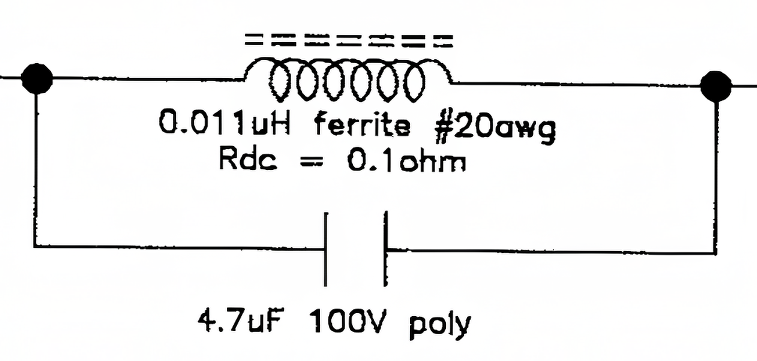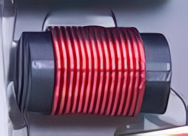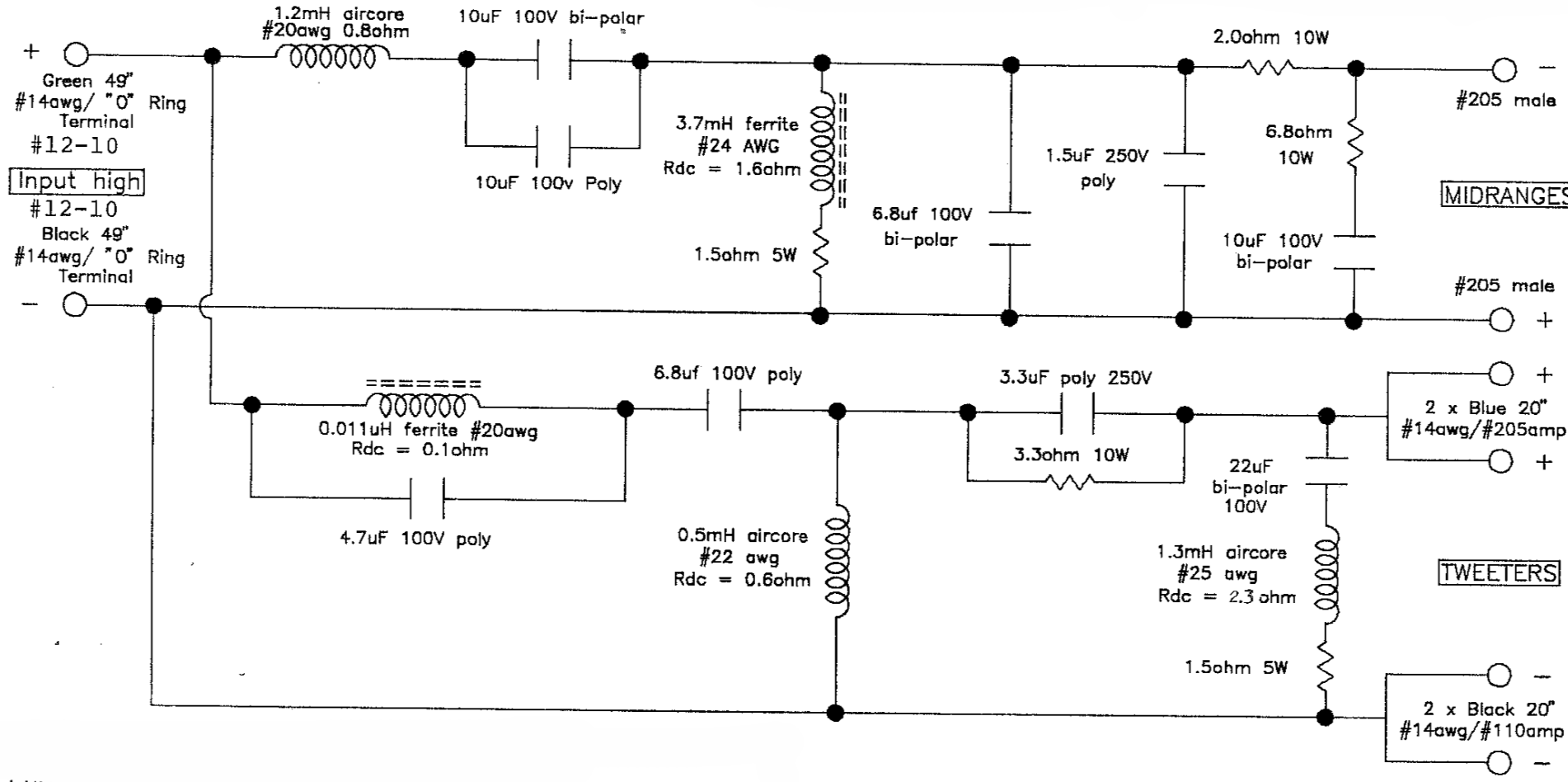I've been repairing/restoring/rehabilitating a great 30-year old pair of speakers and I have some questions stemming from my novice inexperience.
1) In the woofer part of the crossover, the schematic shows a "100uF 100V bi-polar" in parallel with the woofer. My existing crossover, spare crossover that I purchases, and in every photo that I've seen of the crossover, they use two 47uF caps instead of one 100uF cap. Why?
Why not two 50uF caps (which certainly appear to be available)? I understand that two smaller value caps might perform better than one large value cap (correct me if that understanding is wrong), but why use 47uF caps?
I will certainly re-build this cross over with some type of Metalized Polypropylene cap. But do I use two 47uF (maybe with an added higher-quality bypass cap) or two 50uF caps?
2) In the midrange section of the crossover, it has two 10uF caps in parallel wire in series with the midrange drivers. See attached snippet from the schematic:

As with the woofer circuit, I will probably replace these with Metalized Polypropylene caps. I assume I can use one 20uF poly cap rather than two 10uf poly caps without any significant difference in quality. Or will two 10uF actually be much better?
3) In the tweeter circuit there are 3 inductors. The first in series with the tweeters is a very small 0.011uH ferrite core inductor with a Rdc of 0.1 ohm (the other 2 are 0.5mH and 1.3mH inductors wired in parallel with the tweeters). Following the concept that ferrite core inductors are problematic, particularly in series with tweeters, I am considering replacing it.

None of the speaker parts sellers (Madisound, Parts-express, Parts-connexion) have any inductor that small. Is that possibly a typo? (I will have to see if I can measure the inductor) 0.011uH = 0.000011mH = 11nH. Does a value that small make any sense to any of you? I would like to replace it with an air core (for obvious reasons) and I can find air core inductors in roughly that size (0.010 uH) on digikey.com. But the size does seem strange to me. Further, if it is correct, the Rdc of the inductor will almost certainly be different. Do I need to compensate for the different resistance in the circuit, and if so how or where would I do that? This is what the 11nH inductor looks like:


1) In the woofer part of the crossover, the schematic shows a "100uF 100V bi-polar" in parallel with the woofer. My existing crossover, spare crossover that I purchases, and in every photo that I've seen of the crossover, they use two 47uF caps instead of one 100uF cap. Why?
Why not two 50uF caps (which certainly appear to be available)? I understand that two smaller value caps might perform better than one large value cap (correct me if that understanding is wrong), but why use 47uF caps?
I will certainly re-build this cross over with some type of Metalized Polypropylene cap. But do I use two 47uF (maybe with an added higher-quality bypass cap) or two 50uF caps?
2) In the midrange section of the crossover, it has two 10uF caps in parallel wire in series with the midrange drivers. See attached snippet from the schematic:

As with the woofer circuit, I will probably replace these with Metalized Polypropylene caps. I assume I can use one 20uF poly cap rather than two 10uf poly caps without any significant difference in quality. Or will two 10uF actually be much better?
3) In the tweeter circuit there are 3 inductors. The first in series with the tweeters is a very small 0.011uH ferrite core inductor with a Rdc of 0.1 ohm (the other 2 are 0.5mH and 1.3mH inductors wired in parallel with the tweeters). Following the concept that ferrite core inductors are problematic, particularly in series with tweeters, I am considering replacing it.

None of the speaker parts sellers (Madisound, Parts-express, Parts-connexion) have any inductor that small. Is that possibly a typo? (I will have to see if I can measure the inductor) 0.011uH = 0.000011mH = 11nH. Does a value that small make any sense to any of you? I would like to replace it with an air core (for obvious reasons) and I can find air core inductors in roughly that size (0.010 uH) on digikey.com. But the size does seem strange to me. Further, if it is correct, the Rdc of the inductor will almost certainly be different. Do I need to compensate for the different resistance in the circuit, and if so how or where would I do that? This is what the 11nH inductor looks like:


Last edited:
Regarding the capacitors, manufacturers often make use of those they have in stock or of those which offer them the best value when buying in bulk.
Hence the use of two 47 uF capacitors in parallel to emulate a single 100 uF. Use two 50 uF by all means, but it is unlikely to result in an audible difference.
And you could replace the two 10 uF caps in parallel with a single 20 uF.
P.S. What loudspeaker is this?
P.P.S. There may be technical reasons for the mixture of poly and bi-polar capacitors rather than it simply being down to the greater expense of large value poly caps - and its likely the crossover experts may have an opinion on that.
Hence the use of two 47 uF capacitors in parallel to emulate a single 100 uF. Use two 50 uF by all means, but it is unlikely to result in an audible difference.
And you could replace the two 10 uF caps in parallel with a single 20 uF.
P.S. What loudspeaker is this?
P.P.S. There may be technical reasons for the mixture of poly and bi-polar capacitors rather than it simply being down to the greater expense of large value poly caps - and its likely the crossover experts may have an opinion on that.
Last edited:
It's a more common value.but why use 47uF caps?
https://en.wikipedia.org/wiki/E_series_of_preferred_numbers
Maybe it's used for EQ. Why not try winding it yourself..11nH. Does a value that small make any sense to any of you?
Regarding the ferrite inductor in parallel with the poly cap in the tweeter circuit, I believe the generic name for such a circuit is a 'contour network'.
As AllenB implies, its function is likely to be that of modifying the frequency response of the tweeter in some subtle manner.
I submit that substituting an air core coil of the same inductance, but of necessarily greater resistance, would alter the function of the contour network.
I response to your concern about the contour circuit being in series with the tweeter, consider that it may only be active over a limited range of frequencies while leaving the main signal to the tweeter unimpeded. AllenB, being the resident expert on crossovers, is welcome to correct me on that if necessary!
In short, my suggestion is that you leave the LC contour network exactly as it is.
As AllenB implies, its function is likely to be that of modifying the frequency response of the tweeter in some subtle manner.
I submit that substituting an air core coil of the same inductance, but of necessarily greater resistance, would alter the function of the contour network.
I response to your concern about the contour circuit being in series with the tweeter, consider that it may only be active over a limited range of frequencies while leaving the main signal to the tweeter unimpeded. AllenB, being the resident expert on crossovers, is welcome to correct me on that if necessary!
In short, my suggestion is that you leave the LC contour network exactly as it is.